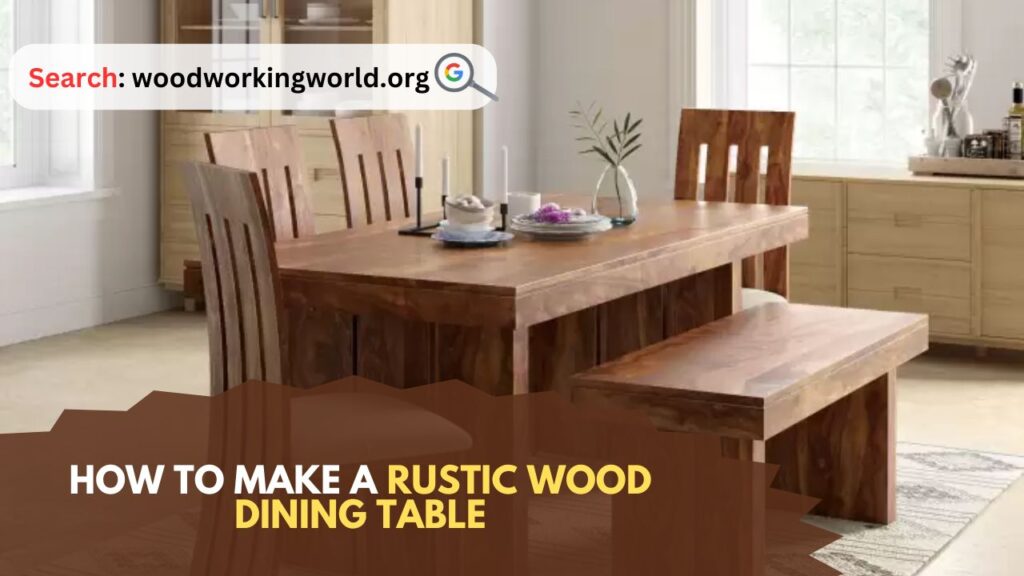Rustic Wood Dining Table: Creating a rustic wood dining table can be a rewarding and fulfilling project, whether you’re a seasoned woodworker or a beginner. The charm of a rustic table lies in its simplicity and the natural beauty of the wood. Here’s a step-by-step guide to help you build your very own rustic wood dining table.

How to Make a Rustic Wood Dining Table
Materials and Tools You’ll Need to Make a Rustic Wood Dining Table
Materials:
- Hardwood boards (such as oak, maple, or walnut) for the tabletop.
- 4×4 lumber for the table legs.
- 2×4 lumber for the apron (the frame that supports the tabletop).
- Wood screws and wood glue.
- Sandpaper (various grits).
- Wood stain and sealant.
- Wood filler (if needed).
Tools:
- Tape measure.
- Miter saw or circular saw.
- Jigsaw.
- Power drill and bits.
- Clamps.
- Sander.
- Paintbrush or rags for staining.
- Safety gear (gloves, goggles, and ear protection).
Step-by-Step Guide
1. Planning and Design
Before you start cutting any wood, plan your table design. Decide on the dimensions that will fit your dining area. A standard dining table is usually around 30 inches tall, 36-40 inches wide, and 60-72 inches long. Sketch your design to include all the parts: the tabletop, legs, and apron.
2. Selecting and Preparing the Wood
Choose hardwood boards that have a rustic appearance, such as those with knots, grain patterns, and natural imperfections. These features add to the rustic charm. Ensure the wood is dry and properly seasoned to prevent warping.
Cut the wood:
- For the tabletop, cut the hardwood boards to your desired length and width. For example, if you’re making a 72-inch long table, you might need six 6-inch wide boards.
- Cut the 4×4 lumber to the desired height of the table legs (usually 30 inches).
- Cut the 2×4 lumber for the apron. You’ll need two long pieces for the length of the table and two shorter pieces for the width, minus the thickness of the legs.
3. Constructing the Tabletop
Lay out the boards:
Arrange the boards side by side to create the tabletop. Ensure the edges are flush and the boards fit together snugly.
Join the boards:
There are several ways to join the boards:
- Pocket holes: Use a pocket hole jig to drill holes at an angle into the edges of the boards, then secure them with wood screws.
- Biscuits: Use a biscuit joiner to cut slots in the edges of the boards, insert wood biscuits, and glue them together.
- Dowels: Drill holes along the edges of the boards, insert dowels, and glue them together.
Clamp and let dry:
Apply wood glue to the edges of the boards, join them together, and use clamps to hold them in place. Wipe away any excess glue and let it dry for several hours or overnight.
4. Constructing the Table Frame
Assemble the apron:
- Attach the 2×4 apron pieces to form a rectangle that fits inside the dimensions of your tabletop.
- Use wood screws and glue to secure the joints. Reinforce the corners with additional screws or metal brackets if needed.
Attach the legs:
- Position the 4×4 legs inside each corner of the apron.
- Drill pilot holes and use wood screws to attach the legs to the apron. Ensure the legs are square and level.
5. Attaching the Tabletop to the Frame
Position the tabletop:
Place the assembled tabletop upside down on a flat surface. Position the table frame upside down on top of the tabletop, ensuring it is centered.
Secure the tabletop:
- Drill pilot holes through the apron into the underside of the tabletop.
- Use wood screws to attach the frame to the tabletop. Be careful not to use screws that are too long, which could protrude through the tabletop surface.
6. Sanding and Finishing
Sand the table:
- Start with coarse-grit sandpaper (60-80 grit) to remove any rough spots and level the surface.
- Progress to finer grits (120, 220) to achieve a smooth finish. Pay extra attention to the edges and corners to ensure they are smooth and rounded.
Fill any gaps:
- If there are any gaps or holes, use wood filler to fill them. Let it dry and then sand it smooth.
Stain and seal:
- Apply wood stain using a paintbrush or rag, following the grain of the wood. Wipe off excess stain and let it dry according to the manufacturer’s instructions.
- Apply a protective sealant, such as polyurethane or varnish, to protect the wood and enhance its natural beauty. Apply multiple coats, sanding lightly between each coat for a smooth finish.
Tips for a Professional Finish
- Test the Stain:
Always test the stain on a scrap piece of wood before applying it to the table. This helps ensure you get the desired color and finish. - Consistent Sanding:
Sand the entire table consistently to avoid uneven surfaces. Spend extra time on the tabletop to achieve a glass-like finish. - Proper Ventilation:
When staining and sealing, work in a well-ventilated area to avoid inhaling fumes and to allow the finish to dry properly. - Use Quality Brushes:
Invest in good quality brushes or rags for applying stain and sealant to avoid streaks and brush marks. - Clamping:
Use sufficient clamps when joining boards for the tabletop. This ensures a tight, secure bond and helps prevent gaps.
Maintaining Your Rustic Wood Dining Table
To keep your rustic wood dining table looking beautiful for years to come, follow these maintenance tips:
- Clean Regularly: Wipe the table with a soft, damp cloth to remove dust and spills. Avoid using harsh chemicals or abrasive cleaners.
- Protect from Heat: Use coasters, placemats, and trivets to protect the table from hot dishes and beverages.
- Avoid Excess Moisture: Wipe up spills immediately to prevent water damage. Use a humidifier in dry climates to prevent the wood from drying out and cracking.
- Refinish as Needed: Over time, the finish may wear down. Lightly sand the surface and apply a new coat of sealant to refresh and protect the wood.
Conclusion: Rustic Wood Dining Table
Building a rustic wood dining table is a project that combines craftsmanship with creativity. The result is a beautiful, functional piece of furniture that adds warmth and character to your home. By following this guide, you’ll be able to create a table that not only serves as a gathering place for family and friends but also stands as a testament to your woodworking skills. Enjoy the process, take your time, and relish the satisfaction of creating something with your own hands.
I hope this article on Rustic Wood Dining Table has been helpful. If you have any further questions, please feel free to leave a comment below.
Video
